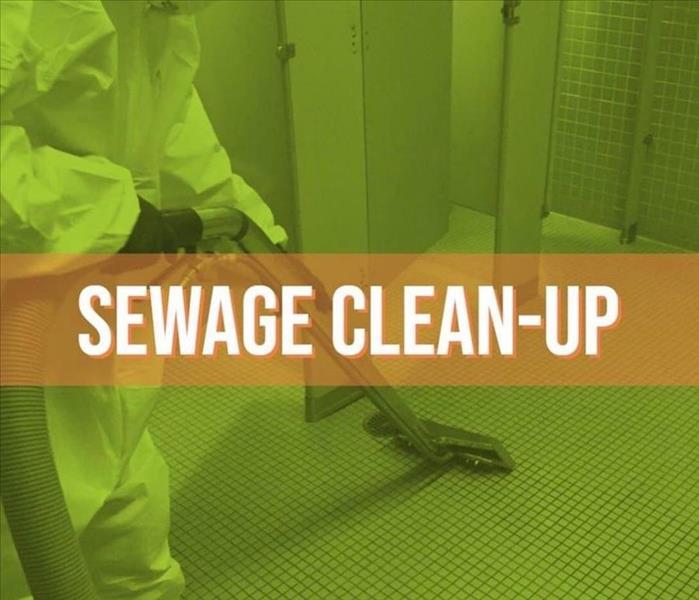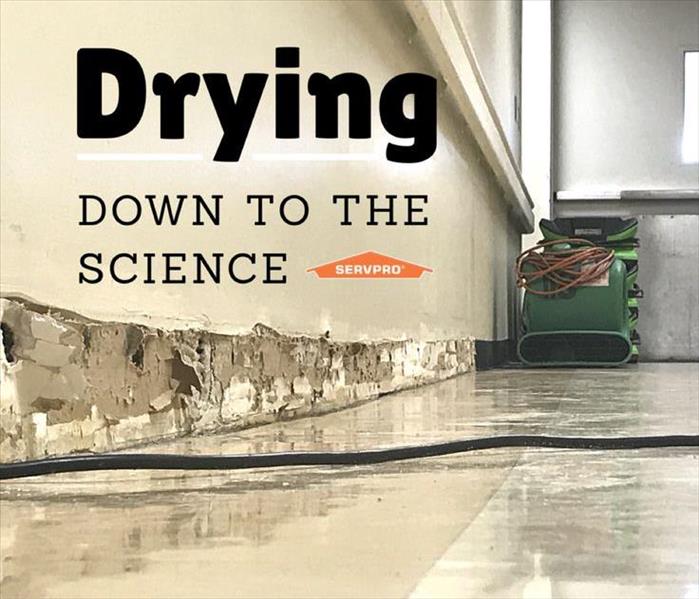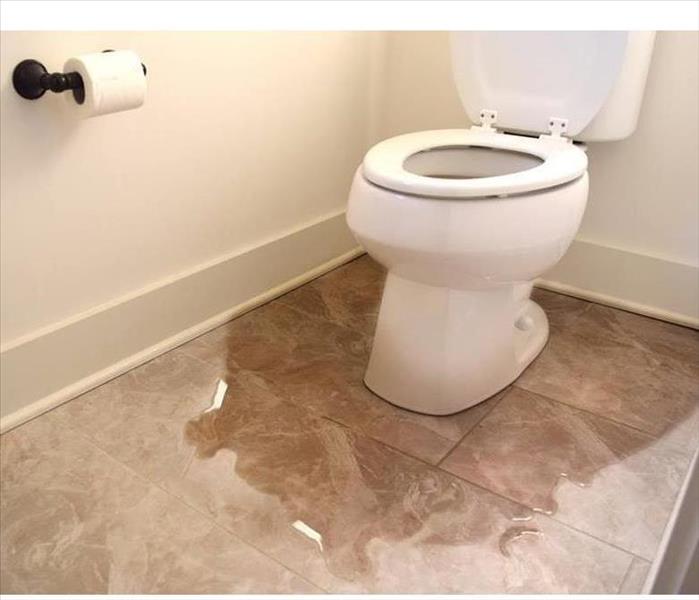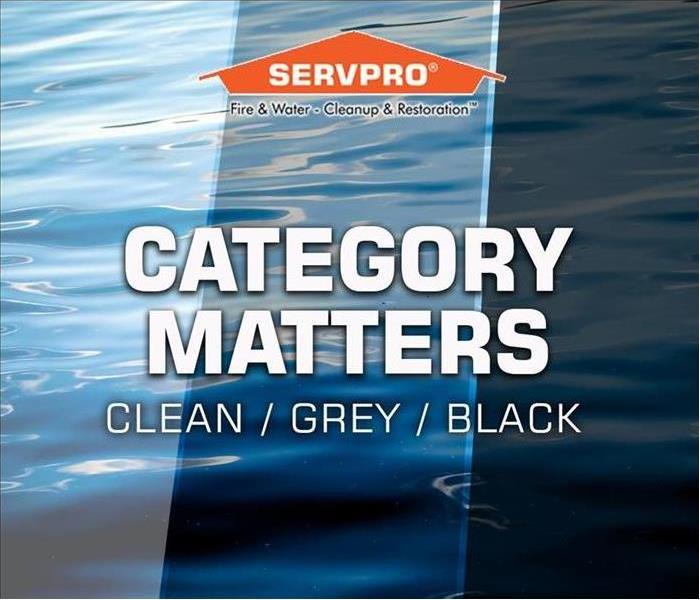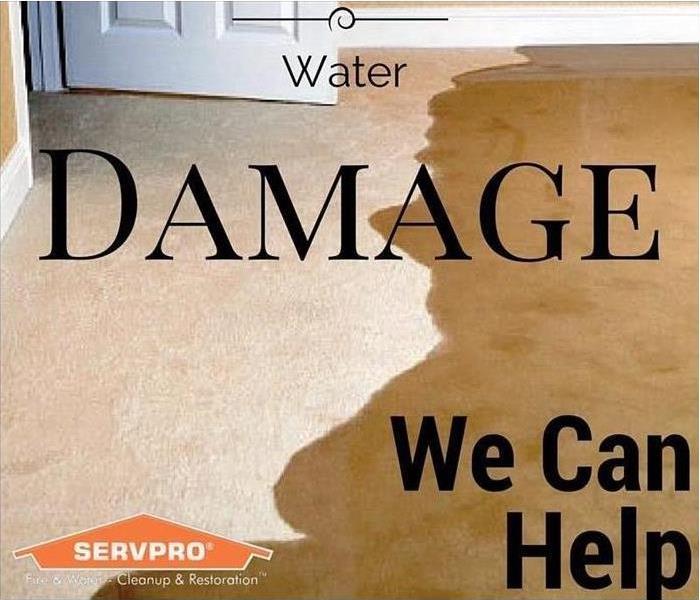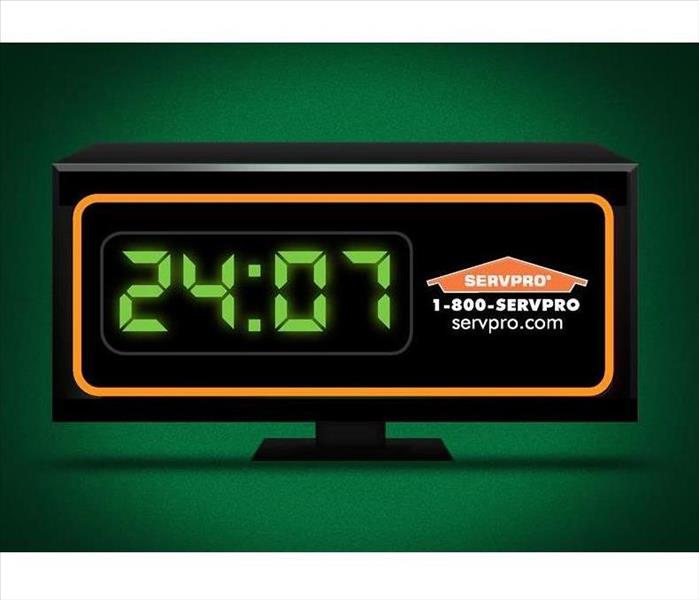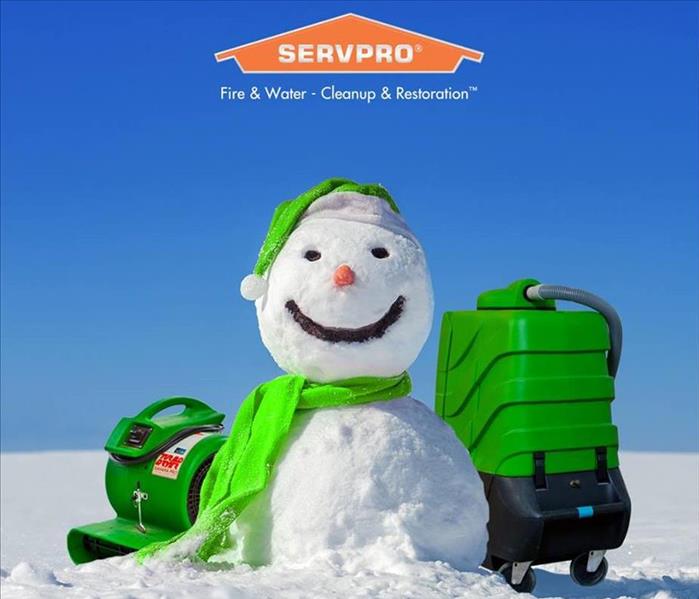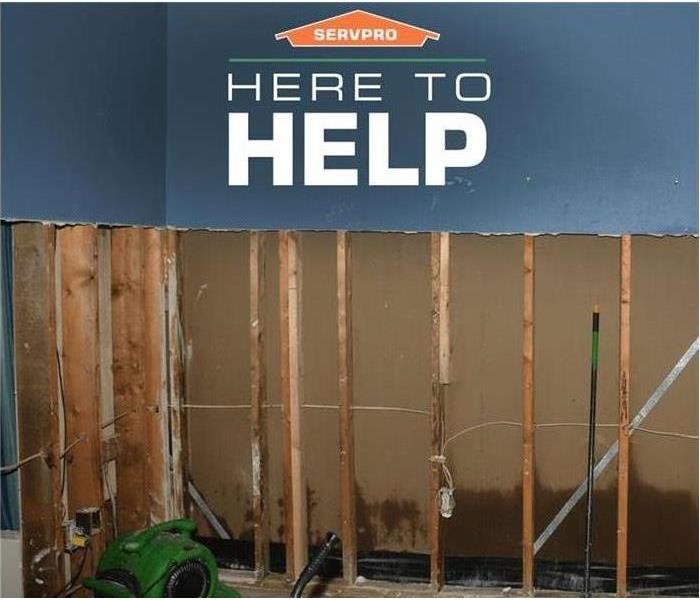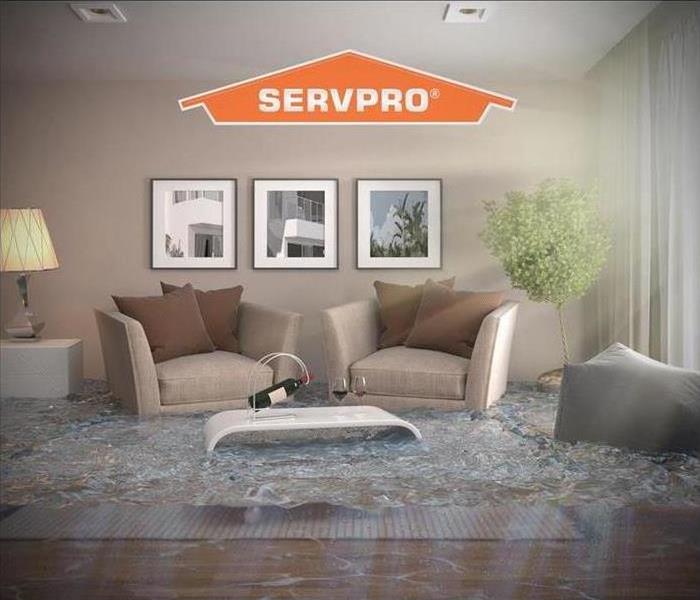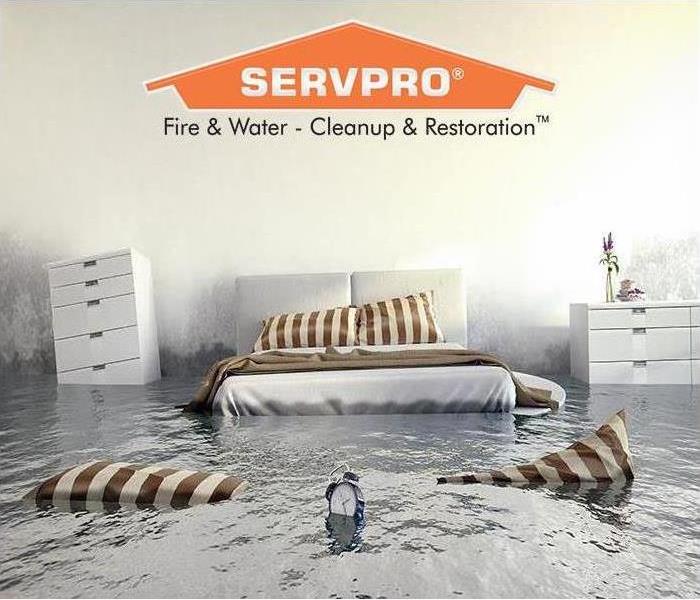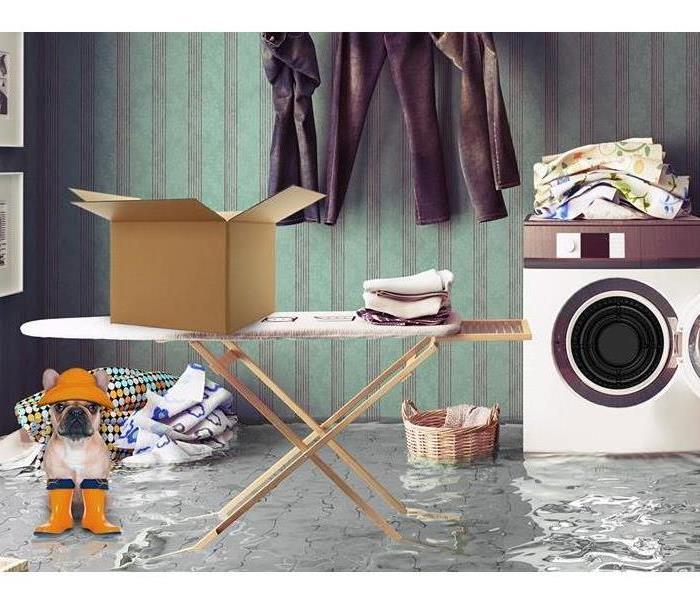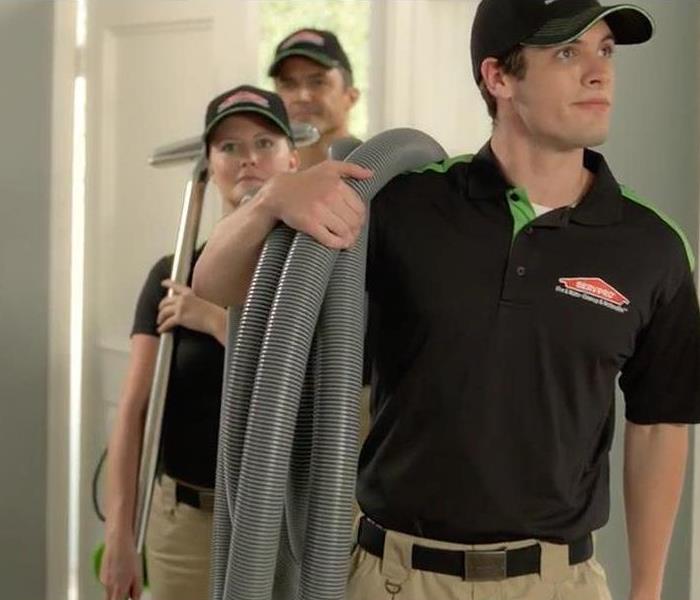Recent Water Damage Posts
Commercial Water Loss
10/2/2023 (Permalink)
One of the most common culprits of damage in commercial building is water. Something that seems simple, like a leaky toilet, can actually leave behind an enormous amount of damage.
Owning or running a commercial building comes with a lot of responsibilities, and catching every drip in your building can feel entirely too tricky. Learn the most leak-prone areas of your building so you can stay proactive about preventing a disaster.
3 Common SourcesThere is never a good time for an unplanned business interruption. Being forced to shut your doors to deal with water damage not only costs you lost income from lack of business, but it can also lead to thousands of dollars in necessary repairs.
Get into the habit of checking a few areas of your building often in order to stop small leaks before they become big:
1. The roof. Roof leaks can be particularly damaging as they can lead to water problems on every level of your building. Roofs can leak when they are damaged in a storm or from age. Clean your gutters regularly, and check your roof for weak spots quarterly. Inspect your attic and roof after any major wind or ice events as well.
2. Bathrooms. Bathroom leaks account for 15% of all water loss in commercial buildings. Toilets and sinks can leak from a hole as small as the top of a pin, and can be hard to detect. Assign multiple staff members on your team to check pipes throughout your building at least once a month to correct problems early.
3. Water heaters/HVAC/boilers. Appliances that have a water line or create condensation have the potential to leak. Backed-up drains or loose pipe connections can lead to puddles near your HVAC unit or changes in your building’s water pressure. Keep an eye out for these issues and address them quickly to stop damages before they become extreme.
Take Preventive StepsWhile you can’t stop a natural disaster, most water damage can be prevented or controlled when you know how to respond during an event. Prepare yourself, your building and your team so you can mitigate damages and cut your overall losses.
Begin preparing by creating a building maintenance plan that includes checking your plumbing monthly. Consider working with SERVPRO as you prepare your plan to build an Emergency Ready Plan that will lay out step by step exactly how to respond in the event of an emergency.
Make sure any planning you do includes taking a look at all the fixtures in your building, as well as checking window and door seals. Locate your water shut-off valves, and assign staff members to turn the water off at the source during a disaster.
A fast response will always be the best way to control the amount of damage water does, so do as much as you can to handle the immediate situation and then call us at 231-723-4872. We are ready around the clock to take your call and start your restoration project. We want to get your building back up and running fast so you can keep work going.
SERVPRO and an attic with mold
3/11/2022 (Permalink)
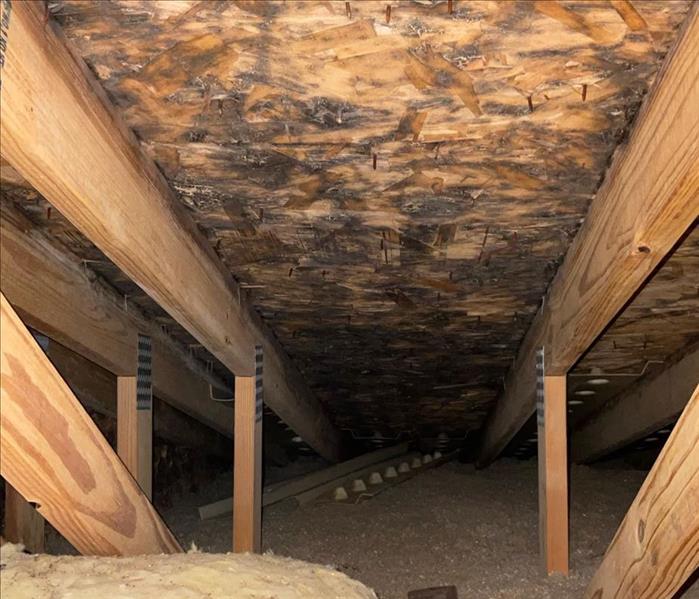
Early last summer SERVPRO of Manistee, Ludington, and Cadillac was called to a home with possible mold issues in the attic. After our inspection we reported that the bathroom vent fan was improperly venting into the attic making the moisture load in the attic high enough to promote mold growth. After properly venting the fan discharge outside thru the soffit we ice blasted the sheeting with high pressure air and dry ice. Following the removal and replacement of the blown in insulation, the attic was returned to preloss condition and the homeowner was able to sell his home. SERVPRO professionals handle water damages on a daily basis and are thoroughly trained in mold removal and the proper way to handle and rid the home or business of the mold issue. SERVPRO of Manistee, Ludington and Cadillac can efficiently restore your home back to a safe and healthy environment. Any questions you may have give us a call at 231-723-4870 to speak with one of our trained professionals today!
Sewage damage and insurance coverage
11/15/2021 (Permalink)
If you live on a city street, your sewer line is probably shared with your neighbor. This means sewer backups will usually not be covered, as the damage came from somewhere other than inside your home. Check your policy carefully as sewage damage is one grey area that varies with different insurance companies. Some don’t cover it at all, some cover structure only (no contents) at a limited amount, and a few companies cover everything. Often the city workers will tell you that the damage was their fault. The city insurance adjuster often does not agree with this statement and coverage becomes an issue. Whether it is covered or not, the sewage needs cleaned up and the experts at SERVPRO of Manistee, Ludington, and Cadillac can help. Give us a call at 877-350-48782.
Call a PRO for your sewage damage
11/10/2021 (Permalink)
To make it more complicated, a full septic tank, overloaded drain field, tree roots blocking the line to the tank, or a collapsed line either in or out of the septic tank all will cause sewage to back up into your home. If there is nowhere for the water and solids to go outside, they will find a way to cause damage inside your home. Often the sewage will come up a basement toilet or shower when water is used upstairs in the kitchen, bathroom, or shower. We have even seen sewage come out of washing machines, laundry drains, or basement sinks. No matter where it comes out, you need to call the experts at SERVPRO of Manistee, Ludington, and Cadillac at 877-350-4872 to make IT "Like it never even happened."
Sewage backup in septic tank?
11/2/2021 (Permalink)
If you live outside of town and own a septic tank system, sewage backup questions are still a grey area in your policy. Many insurance companies treat the septic tank as an extension of your plumbing and as a result cover any loss. Others either deny the claim or cover a limited amount for structure cleaning only. Sewage losses do vary by company and you must take the time to read your policy or call your agent BEFORE you have a loss. This is one area you can compare insurance companies as some cover things others deny. While we cannot guarantee coverage, we can guarantee that the experts at SERVPRO of Manistee, Ludington, and Cadillac will clean up the mess and remove the offensive odors. Give us a call at 877-350-4872 to get started.
SERVPRO can help with your sewage questions.
11/1/2021 (Permalink)
During the nearly 20 years that I have been carrying the pager for after hours calls, I am often surprised at sewage coverage questions that I get from homeowners. As always, I start with the disclaimer that the experts at SERVPRO of Manistee, Ludington, and Cadillac do not make coverage determinations, as that is solely the responsibility of your adjuster. After doing thousands of water losses over the years we do see pretty clear patterns on what is and isn’t covered. The rules are surprisingly consistent for the 40-50 different insurance companies that we work with. First, the water must originate inside of the insured home. This means no ground water coming in your sump pump, sliding door, walls, floor, windows or sewage system. Give us a call at 877-350-48782 and we can talk you through your loss. We are always here to help.
Is my sewage damage covered?
11/1/2021 (Permalink)
If you live on a city street, your sewer line is probably shared with your neighbor. This means sewer backups will usually not be covered, as the damage came from somewhere other than inside your home. Check your policy carefully as sewage damage is one grey area that varies with different insurance companies. Some don’t cover it at all, some cover structure only (no contents) at a limited amount, and a few companies cover everything. Often the city workers will tell you that the damage was their fault. The city insurance adjuster often does not agree with this statement and coverage becomes an issue. Whether it is covered or not, the sewage needs cleaned up and the experts at SERVPRO of Manistee, Ludington, and Cadillac can help. Give us a call at 877-350-48782.
When you call one of our offices with a water loss
3/3/2021 (Permalink)
When you call one of our offices in Manistee, Ludington, or Cadillac with a water loss we will ask you a series of questions:
Customer information:
- In the first group is the standard name and address.
- Preferred contact info (home, office, or cell phone). Some customers actually prefer email or text messages
- Loss site info: this may be different from the callers contact info and we need to know where to send insurance and/or billing information.
- Self-pay or insurance company. This gets important if you are going to file a claim. We deal with hundreds of insurance companies and much of the information they collect is not industry wide standard. If we know the insurance company, we can collect everything they need up front without going back and redoing their specific forms.
Loss information:
- Type of structure. This tells us what we are likely to find on site. Is it a home or office, do people live or work there, and often tells us how the building was built.
- How old is the loss site. This tells us if we are likely to find lead paint, asbestos, or other harmful items.
- How many rooms are affected. The size of the loss lets us get enough technicians on site to get it under control and help make it "Like it never even happened."
- Are power, heat, and water available? Again, allows us to bring whatever is needed to attack the problem.
Claim information:
- Date of loss. If we know how long the problem has existed it allows us to determine if it is an emergency, is it likely mold has developed, will the insurance company pay after hours charges, or are we likely to run into biohazard issues?
- Adjuster information. If you have filed a claim, we can contact the adjuster immediately and get permission for items that may be of concern to your insurance company.
- Agent information. Often your agent would like to be kept informed on the process and progress of working on the claim.
- When you would like a crew on site? Sometimes homeowners are out of town and do not have access to the building until they drive up to the loss. Or maybe do not want anyone onsite until after closing hours.
The last thing we may ask is how you found us. This allows us to fine tune our marketing so our customers can find us when they need us, whether by using references, Internet, phone book, or social media.
It seems like a lot of information. But information we get up front really helps the process go smoother for you, your agent, your adjuster, and your insurance company. If you can’t answer all the questions, don’t worry. You can still call your friends at SERVPRO of Manistee, Ludington, and Cadillac at 877-350-4872 and we will still send a crew and begin to make it "Like it never even happened."
Preventing frozen pipes
2/16/2021 (Permalink)
It's February in Michigan. That means it's cold. With the "2021 version of the "Polar Vortex" firmly over us, SERVPRO of Manistee, Ludington, and Cadillac is starting to get the annual frozen and burst pipes calls at the offices. While there isn't much we can do about the temperatures outside, we can pass along some hints we saw in the DTE Energy Smarts for Michigan Small Businesses Winter 2021 issue. They list 7 top things you can do to save money and keep your home or business warmer this winter.
- Your HVAC really does need an annual tune up for several reasons. Cleaning and maintaining the system will make it run more efficiently as well as help prevent breakdowns when you need it most. Do it before it breaks and the HVAC guys will really appreciate not having their 5thcall of the night when it’s 20 below.
- Install a programmable thermostat can save you a ton of money. Just remember to replace the battery every year as the thermostats aren’t usually hardwired and if the battery fails, so does your heat. And if you are in Florida when that happens, you will be calling SERVPRO for frozen pipes.
- Change your filters. This goes along with the annual tune up but it is one of the most cost effective ways to keep your HVAC system running efficiently. If you hold the filter up to the light and cannot see light, it needs changed.
- Use the sun. If you are home, opening and closing blinds and curtains can really help your furnace and can save money. Insulated drapes will pay for themselves in just a few years.
- Keep registers and vents clear. Do not block them with furniture, rugs, or debris. If the air cannot circulate, your furnace will need to run much longer to heat your home and that means more money out of your pocket.
- Look into upgrading your system. Modern improvements have made HVAC systems much more efficient. They really do pay for themselves in just a few years.
- Finally, their list included lighting upgrades. While that is mainly a safety issue, motion sensors and timers can also save money.
The experts at SERVPRO of Manistee, Ludington, and Cadillac would be happy to help if you have frozen pipes, but keeping them from freezing makes us smile also. If you do have issues give us a call at 877-350-4872 and let us make it "Like it never even happened."
Will you have coverage if you have a water loss and should you file a claim?
12/2/2019 (Permalink)
 A flooded living room. Water damage caption with SERVPRO logo.
A flooded living room. Water damage caption with SERVPRO logo.
There is no yes or no answer. Where did the water come from is the first question that needs answered. Most homeowner’s policies will only cover water damage if it originates inside the structure. A partial list includes; broken pipes; toilet, sink, washing machine, or tub overflows; burst supply lines, drains, or water heaters; or even broken fish tanks. Leaks such as a rusted out water heaters or pipes, can be a grey area with some policies covering them and some not. Roof leaks will be looked at carefully also. Sewage back up is another grey area that is or is not listed in your policy. Ground water from outside is rarely covered. Some policies require that the structure be occupied to have coverage applied. However, most of the time the loss is covered if the water came from inside the home.
The average water job done by SERVPRO's in Michigan is approaching $3,500 for drying only. This does not include replacement of contents or rebuilding the home. While having a professional dry your home can be expensive, so can not properly drying it and allowing mold to grow. Mold starts growing in 48 to 72 hours and becomes visible in a week. Microbial amplification can be expensive to clean and cause serious health issues so every effort should be made to prevent it. Mold is another area that some policies cover and some specifically deny although many cover mold if it is caused by a covered loss. On the flip side, we get called to losses frequently where there is no work or it is small enough that the homeowner can take care of it themselves. It just depends.
Another thing to consider is your claim history. If you have had multiple losses some companies will review your policy for coverage or pricing. Some won't so that is always a question to ask your agent. The value of your time and your handyman skills also influence your decision. If you can do some of the work yourself or were going to do some remodeling anyway you may be able to do the work. You will probably need to follow the policy "when in doubt, cut it out". It is also still best to have a professional at least put meters on it to be sure you don't have hidden water that will cause mold or other issues down the road. You will need to get the water out of the building and not just move it around with air movers. This may mean renting or buying dehumidifiers or opening windows depending on the weather.
A big concern is where the water went. If it got into insulation or behind a vapor barrier, it will need to be opened up. Multiple layers of floor coverings, plaster and lath, blown in insulation, particle board floors, and belly pans from modular homes are other areas of concern. Laminate floors, some water resistant carpet pads, and sleeper floors can also trap and hold water. Contents can be another do-it-yourself problem with many posing specialty drying skills. Again, how much help you can get from Mother Nature is huge when drying large items. Many items stored in basements are often not worth cleaning and can be disposed of properly.
We at SERVPRO have seen many cases of DIY project ending well but you do need to be careful. The experts at SERVPRO of Manistee, Ludington, and Cadillac would be happy to assist you on your loss at whatever level you require, from advice to turn key.
Finally, the Drying Process.
7/1/2019 (Permalink)
The drying process usually takes 3 or 4 days and is quite intrusive. After demolition has been completed, drying equipment will be set. The fans are loud and generate a significant amount of heat in the summer. The area is truly a construction zone. Care must be exercised because many hazards exist include tripping hazards from the power cords, uneven floors from demolition or floating carpet, possible nails and screws protruding from walls and floors, and possibly dust and debris. A reputable contractor will make every effort to keep everything cleaned up each day, but some construction debris is inevitable.
SERVPRO of Manistee, Ludington, and Cadillac will be onsite every day checking moisture readings of all materials, resetting drying equipment, and removing equipment as specific areas dry. This daily monitoring is critical to the process to make sure no wet areas remain which could support microbial amplification, and to prevent over drying of sensitive items. These reports provide evidence which can be used in court to prove that the structure was properly dried and is ready for reconstruction. They also explain why all work was done what the thought process was involved in making the drying decisions.
Once everything is dry, the equipment will be removed and contents reset to allow you to have use of the home. If reconstruction is necessary the next phase of the loss starts. See our reconstruction blog for the breakdown of that process. Although this is a simplified breakdown of the drying process, hopefully it will allow you to feel more comfortable with dealing with your loss.
We have the contents out of the way, what is next?
6/1/2019 (Permalink)
The contents are out of the way, carpet pad removed, and free water has been extracted. Often water will wick up the drywall or wall coverings following the initial loss. Or perhaps, the water came from above from a main or second floor toilet or kitchen. SERVPRO of Manistee, Ludington, and Cadillac technicians will use a variety of tools and meters to moisture map the affected area to determine if demolition is necessary. Penetrating and non-penetrating moisture meters, moisture sensors, thermo-hygrometers, and inferred cameras are a few of the tools needed to moisture map a structure.
The walls can sometimes be dried without cutting by using dehumidifiers and high speed axial air movers. Restoration companies always try to minimize cutting to reduce reconstruction and disruption to your life. If the walls are only wet a few inches high, the baseboard will be removed and fans set. Sometimes cutting below the baseboard line is possible if the water has not wicked very high on the wall coverings. This is the preferred method since it does not require any drywall repairs which greatly reduces the time you will be unable to fully use your home.
If a moisture barrier is present or if the insulation on exterior walls was affected, more intrusive cutting may be necessary. The walls may need to be “flood cut” at one foot, 2 feet, or 4 feet. Sometimes the subfloor will need to be removed if it has deteriorated or swollen to the point that it is structurally unsound or will not accept new floor coverings. Vinyl floor coverings may need to be removed to dry the subfloor as they present a vapor barrier which doesn’t allow the subfloor water to escape. Drying ceramic tile and hardwood floor are a specialty drying challenge that the experts at SERVPRO of Manistee, Ludington, and Cadillac are trained to perform. Laminate floors are discarded if water gets under them.
So now that we have walls and floors ready what happens next?
See our next blog for the answer to that question.
We now have a drying plan. It starts with protecting your contents.
4/30/2019 (Permalink)
The next step usually involves getting the free or unbound water out of the building. This includes pumping and extracting the standing water and removing the wet carpet pad. Before this can happen the contents will often need to be moved. Large furniture, beds, pool tables, book cases, and television stands present challenges when they are setting on the wet carpet or in a pool of water. If there is an unaffected area in the home SERVPRO of Manistee, Ludington, and Cadillac would prefer to dry the contents on site.
The drying chamber we set up to dry the structure creates the perfect conditions to dry the contents. Protecting the contents is an important step in the drying process. Wet nonporous contents will be wiped dry and removed from the affected area or boxed to protect them from further damage. Porous contents will need dried either on site or back at the shop in Manistee, Ludington, or Cadillac. All wet laundry will be inventoried and sent to a local laundry facility for cleaning and drying.
On large losses where the insured must move out of the building during reconstruction, all of the contents may need to be removed and stored offsite. This part of the dry out, called a pack out, is not always needed but can make the reconstruction portion of the loss much easier. If reconstruction does require a pack out, the build back is usually is large enough to take several months to complete. This means you will want access at least some of your seasonal contents or clothes. It is not unusual for a customer to call us three months after a pack out and request Easter baskets, or grilling tools, or snow shoes. You should expect the storage facility to allow you to have access to your contents as needed.
Congratulations, you have coverage.
4/11/2019 (Permalink)
Let’s get drying. A quality restoration company will moisture map your home to determine what is wet and what is savable. This helps in developing a drying plan to start getting you back to preloss condition “Like it never even happened." Pictures will be taken (with your permission) to document the damage for the insurance company. Over the past 17 years SERVPRO of Manistee, Ludington, and Cadillac has developed relationships with nearly all insurance companies and their adjusters in western Michigan. They know and trust us and we know them and what they need.
We have national contracts with many of the insurance companies and know exactly what they require to quickly settle a loss. We use their estimating software and price lists so there is never a problem with the price we invoice to the insurance company. Because some insurance companies have specific forms, we have I-pads with the forms pre-loaded if we meet you on site. In west Michigan losses often occur in seasonal homes (or you may be a snowbird soaking up the sun down south). We can mail, fax, or email the forms for you or your representative to sign and return.
Determining the “type” of water damage is critical to before any work is started. The Institute of Inspection Cleaning and Restoration (IICRC) has written a standard of care (S-500) which is recognized nationally as the drying standard. You should ask your restoration company if they are IICRC certified and follow the S-500. The S-500 lists 3 types of water damage, Category 1, 2, and 3 depending on the source of water. Category 1 water originates from a clean water source which is usually a broken pipe, water supply line, toilet bowl breakage, washing machine supply line, sink overflows, etc. This water is not considered to pose a substantial risk to human health. If materials affected by Category 1 water are dryable, they can be saved.
Category 2 water contains significant contamination and has the potential to cause discomfort or sickness if contacted or consumed by humans. This water can come from discharge from dishwasher or washing machine, toilet bowl overflows (without solids), broken aquariums, leaking water beds, fire suppression systems, or ground water coming through walls or floor. Items wet with Category 2 water that cannot be cleaned should be discarded. This would include carpet pad, drywall, and some contents.
Category 3 water is grossly contaminated and contains harmful agents that can cause serious illness if consumed by humans. This water category includes sewage and toilet overflows from beyond the trap (with or without solids). All forms of surface flooding from outside the structure are considered Category 3 due to the possibility of contamination from silt, organic matter, pesticides, heavy metals, regulated materials or toxic organic substances (you never know what your neighbor has stored behind his garage).
Many insurance companies have limits on if and how much Category 3 losses are covered depending on where the loss originated. If it came from a septic or city sewer back up losses may be limited. If it originated from inside the structure from an overflow or broken pipe you should be fine. Once they determine the category of water, the restoration company will know what can be cleaned and dried and what must be discarded. Any item discarded must be documented and photographed. The insurance company is going to want to know what they are paying to replace.
So now that we know what type of water damage it is what happens next?
See our next blog for the answer to that question.
So you had a “Water Loss”?
3/7/2019 (Permalink)
So you had a “Water Loss”?
The first question we get from customers who have had a claim is what is the process?
The first steps are obvious, prevent further damage by removing the source of water.
- Turn off the water supply at the street or well
- If there is a broken pipe, call a plumber to cap a line or repair a leak
- Clean the sewer line or get the septic tank pumped if it is a sewage backup
- Clear the snow and ice to relieve an ice dam.
- Verify that the sump pump is working if ground water is entering the structure
- Remove ice or snow buildup outside the building to divert water away from the structure
- Clean or repair the roof gutters to divert water away from the building
- Call a roofer to patch a leaking roof or skylight
The most important question from every homeowner is do I have coverage? The only person who is qualified to answer that question is the adjuster assigned to the loss by the insurance company. SERVPRO cannot make that determination, the agent cannot, your nosey neighbor or mother-in-law cannot, and the internet darn sure cannot. The adjuster will either inspect the loss or interview you to find out what caused the loss. He will then read the policy to see if it covers that specific event. Most policies cover broken pipes or ice dams but many do not cover sewage backup or groundwater intrusion. Where the water originated is important and the adjuster will need to document the cause.
Your policy is a contract between you and your insurance company that spells out specifically what coverage you are paying for and under what conditions they will pay. For example, your policy usually will cover a frozen pipe but specifically states that you are covered only if you “maintain heat”. If you don’t pay your gas bill or let the propane tank go empty, the coverage is voided. The adjuster (insurance company) will often require that you send them copies of your heating invoices for the last 2 months to prove that you maintained heat if the loss occurs in the winter.
Some policies also require that you occupy the home and refuse to cover the loss if you left for several months to stay at a seasonal home or sometimes even if you were hospitalized or in a nursing home. Other coverage problems can arise if you use the home as a rental property but do not buy that type of policy. You must read your policy and talk to your agent to make sure the coverage you purchased is exactly what you need or want. Your agent is an expert on the various policies and should steer you into the coverage you need after asking you questions on how you use the home. And remember to update your policy as circumstances change.
Check out our next blog to understand how you can sometimes get coverage without your insurance company paying.
Sewage problems?
10/16/2018 (Permalink)
A big shout out to SERVPRO of Manistee, Ludington, and Cadillac's Scottville crews of David, Victoria, Donnie, Cody, Johnathon. They spent most of last week in full PPE (Tyvek suits, rubber suits, boots, gloves, and full-face respirators) under a local home after a sewage spill flooded the crawlspace. The job involved scooping the "solids and liquids" into pails, sliding them on a sled to the access door, and transferring them to goose neck bags for proper disposal. Working all day on your knees in a crawlspace filled with sewage is not fun but they did a great job making the home safe for the owners and their children.
If you Google sewage you will get lots of advice on how to clean it up. It ranges from soaking it up with kitty litter, covering it with lime, covering it with plastic and dirt, and a whole list of fixes that are just dangerous. I'm sure if you look far enough someone will even have a recipe for mixing white vinegar and baking soda to make it as good as new. Nope. Two words, source removal. You must get it out of there. Hire a septic cleaning company to pump out any standing water. You can do it yourself if you have access to a sanitary sewer to properly dispose of the sewage water. Note: it is illegal to put it down the storm sewer. If you get caught, it will be expensive.
Once the standing water is gone, the feces and solids must be mucked out and disposed of properly. Be careful who you hire for this portion of the project. Make sure the company you hire is insured and requires their employees to wear safety gear (PPE). If the employees get sick or injured, you could be liable for any costs. The solids must be also be disposed of properly. Some cut-rate businesses have been known to toss the sewage in the woods and ditches. Again, you are liable if your sewage is disposed of improperly. Once the solids have been removed, you will also need to remove at least some of the contaminated soil.
Replace it with fresh sand and apply an EPA registered disinfectant to retard bacterial and microbial growth. Place a fresh layer of 6 mill black plastic over the affected area and clean any splashes off the structural portions of the home. You are now ready to dry the structure. Dehumidifiers and air movers may require returning the walls, floors, and joists to preloss condition and dry to below 16% moisture content to prevent mold growth.
As with any disaster time is critical. If you smell any unusual odors coming from your homes' crawlspace, check it out immediately. Then call the professionals at SERVPRO of Manistee, Ludington, and Cadillac to make it "Like it never even happened".
Are you aware if you have flood insurance coverage?
9/25/2018 (Permalink)
Do you need to buy National Flood Insurance from the NFIP (FEMA's National Flood Insurance Program) if you live in Western Michigan?
If you have a flood, your home insurance is probably not going to cover anything. Most home policies covering water damage require that the source of the water originate inside the structure. If ground water comes up from the floor or through the walls you are probably not covered. If it runs down your driveway and into your new egress window into the basement bedroom, no coverage. If it bubbles up from the city sewer, no coverage. If your sump pump quits and groundwater floods your basement, probably no coverage (unless you bought a limited sump pump policy rider).
There are a few exceptions. Often the homeowner’s policy covers sewage back up if it comes from your septic tank system (some policies consider the tank, drain field, and lines part of the homes plumbing). A few sump pump policies will cover you from sewer backups on your portion of the line to the city system. Read your policy carefully. You should have coverage if a tree falls on your home and damages the roof or high winds damage the home and allows rain to enter. Ice dams are usually covered. Other than these few exceptions the answer is usually “no coverage”.
According to FEMA, the average cost of one inch of water in your home approaches $25,000. USA Today says only 10-20% of North Carolina coastal homes and less than 3% state wide have flood insurance. The main reason obviously is cost. A policy in a high-risk area can easily exceed $10,000 a year. This cost is established by the government based on the risk assessment maps produced by FEMA. Much of western Michigan has been mapped and you can view your area by entering your address at the FEMA Flood Map Service Center. Most of our area is listed minimal or low risk of flooding which drastically reduces the annual premiums.
But flooding can and does happen. According to FEMA more than 20% of flood claims come from properties outside high-risk flood zones. If you live in a marginal flooding area of western Michigan, SERVPRO of Manistee, Ludington, and Cadillac recommends that you check the pricing on these low risk area policies. And please, read the policy carefully to determine exactly what is and is not covered. Also, do not hesitate to contact your local homeowner’s insurance agent and get his advice on protecting what is probably your most valuable asset.
Far too often SERVPRO of Manistee, Ludington, and Cadillac gets called to help flooded homeowners in Western Michigan and we must tell them to call their agent, but that they probably do not have coverage. Don't let that happen to you.
Sewage disaster
5/16/2017 (Permalink)
OH NO! You have sewage in your basement/crawlspace. Do you have insurance coverage for that? That is the hardest question SERVPRO of Manistee, Ludington, and Cadillac gets asked in a typical day. The answer is “Maybe”, it depends on exactly what your policy says is covered. Most home policies cover the structure and everything in it. This is where it gets sticky. Is it your “poo” or the neighbors’? Let’s try to sort it out for you.
If you have a septic system there is a good chance you will have coverage since many insurance companies consider the septic system a part of normal home “plumbing”. You still will need to call your agent who will probably defer to your adjuster for the ruling. Another thing to be aware of is that the “sewer backup” part of the policy normally does not cover contents. This should be a hint for you be very careful of storing valuable or unreplaceable contents on the basement floor. Sewer back up on home policies often have a limit of $2,000 to $5,000 and may or may not cover mold growth.
If you are on a city sewer, your chances of being covered are much slimmer. Most home policies will not cover the loss and it is very difficult to convince the city that it is their problem. You have to prove that they either had design issues or possibly a pump failure and that’s tough to do. Also remember that there is a big difference between a sewage backup and ground water back up from the sump pit or floor drain. As always, read the fine print on your policy before you renew to prevent a nasty surprise when it happens to you. And don’t forget to call the experts at SERVPRO of Manistee, Ludington, and Cadillac at 231-723-4872 if you need help.






 24/7 Emergency Service
24/7 Emergency Service

